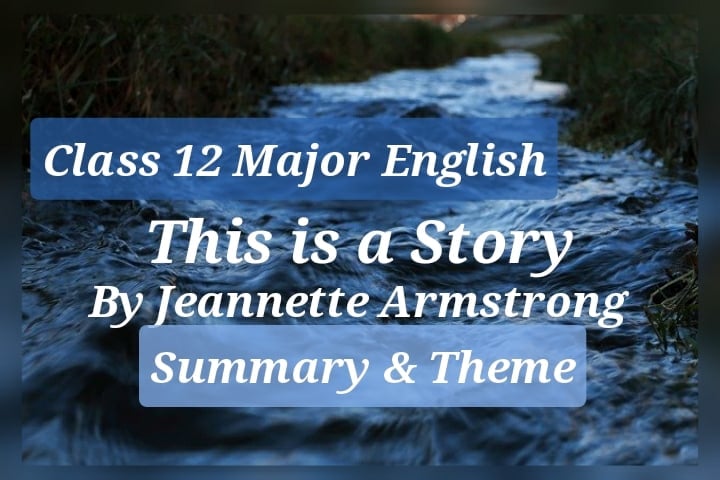This is a Story by Jeannette Christine Armstrong: Summary and Theme: Class 12 Major English
Setting: Place: Okanagan/Canada
Time: Day Time
Characters:
Kyoti: An Animal: It is presented as a human being.
The Narrator: She tells the story in the first person narrative.
George
Okanagan People
Tommy: Villager’s Head
An Old Woman: She belongs to the native people of Okanagan
A Young Boy: The boy takes care of the Okanagan River.
Summary and Theme of This is a Story by Jeannette Christine Armstrong:
This is a Story is a story by Canadian writer Jeannette Christine Armstrong. This story presents the theme of colonization. In the same way, it also presents the theme of loss of native cultures. People lost their culture after colonizers’ arrival in their native land. The native people lost their native culture-Okanagan culture. They became oblige to follow colonizers culture. It also presents the theme of alienation and migration. The story is presented in the first person narration.
At the beginning of the story, the women were gathered at Owl Rock. We find shining sun. It’s hot. The narrator addresses the gathering of the women. She starts telling a story to pass time after the request of George. Her story goes like: Once, Kyoti was returning from Columbia river to Okanagan river. He noticed different unusual changes in his village.
People were following colonizers culture instead of their own. He found many changes in his village after the arrival of European colonizers. He calls them swallow people. He found colonizers houses everywhere. He didn’t find native Okanagan people there. He found a strange damp there. It blocked the Chief Joseph River.
Once, he used to bring Salmon fish to the villagers to make them happy. But now he found that the damp had blocked the flow of the fish. The Kettle falls had dried now due to the damp. People used to do fishing there. But people shifted to another place after the construction. People couldn’t do fishing after the construction.
The narrator got a chance to meet two Okanagan people there. They were fishing there. He tried to talk with them in the native language. But they failed to understand the language. They failed to understand because they adopted the colonizer’s language instead of their native language. He also met an old woman. She could speak the native language. She was still following her tradition and culture. She became happy to meet him after a long time. She started to cry after recognizing him.
The old woman claims that the native people started to follow the colonizers culture and lost their own. She called the colonizers monsters. She didn’t like modern houses and cultures of the colonizers. She hated them for imposing their culture on the native Okanagan people.
The old woman suggested Kyoti to visit the headman, Tommy in the North. On his journey to the North, he found Okanagan people living in the colonizers modern houses. He also met many headmen on his journey. He advised them to clear the damp to allow the free movement of the Salmon fish.
People were eating the food of the colonizers forgetting their native food. He believes that the food is not healthy for them. He advised the headmen to eat native food instead of the modern food. The headmen didn’t like his advice. He was threatened and misbehaved by them. He found that they were captured by the colonizer’s culture and lifestyle. Their mentality doesn’t allow them to disrespect colonizers.
They were afraid of the colonizers. They have accepted the colonizers regime. They get job, money and food for following the culture. So, they are in a trap of the colonizers. They can’t go beyond the trap. Their resources were misused by the colonizers. Okanagan people were mistreated by them. Rivers were polluted by them.
Then, Kyoti meets a young boy. He was looking into the river because he was instructed by his mother to do it. They talked in the native language because the boy could understand it. His mother was instructed by their new headman, Tommy to look after the river. The boy’s ancestors were the chief of the Kettle falls.
They dreamt to see salmon fish there. But they never fulfilled their dream. The boy expects that one day he will see the river full of salmons. Kyoti goes to meet Tommy and Okanagan people. He calls them to break the damp to clear the free movement of the salmons. Kyoti wants to make native people feel the joy of flowing river and salmons.
In this way, the story ends showing the poor condition of native Okanagan people and culture. They lost their identity and heritage after the arrival of the colonizers. They are suffering from identity crisis. They are following colonizers culture unwillingly. They are afraid of the colonizers rule.

